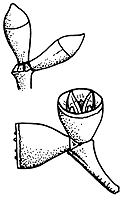Common name: Sydney blue gum
Eucalyptus saligna Sm. APNI* 
Description: Tree to 50 m high; bark smooth, powdery, white or grey, shedding in short ribbons or flakes, sometimes persistent on lower trunk.
Juvenile leaves disjunct, ovate, glossy green to dark green.
Adult leaves disjunct, broad-lanceolate, 10–17 cm long, 2–3 cm wide, dark green, glossy, discolorous, penniveined. Umbellasters 7–11-flowered; peduncle narrowly flattened or angular, 4–18 mm long; pedicels terete, 0–3 mm long. Buds ovoid to cylindrical or fusiform, 5–8 mm long, 3–4 mm diam., scar present; calyptra conical (slightly beaked), as long and as wide as hypanthium.
Fruit cylindrical, pyriform or campanulate, 5–8 mm long, 4–7 mm diam.; disc depressed; valves exserted.
Distribution and occurrence: Widespread and abundant, in wet forest on soils of moderate fertility, often on slopes; north from Port Jackson.
NSW subdivisions: CC, NT, CWS
Other Australian states: Qld
All populations south of Port Jackson show some genetic influence from E. botryoides, typically manifested as a scattering of stomates on the upper surface of the leaves (leaves of E. saligna have the stomates more strictly confined to the lower surface with stomates on the upper surface only along the midrib) and some rough bark. Local introgression of these populations with E. botryoides has also produced a number of more recent hybrid swarms. Plants with the general appearance of E. saligna extend as far south as Batemans Bay, then becoming more like E. botryoides south into East Gippsland in Victoria.
Text by K. Hill
Taxon concept: Flora of NSW 2 (1991)
APNI* Provides a link to the Australian Plant Name Index (hosted by the Australian National Botanic Gardens) for comprehensive bibliographic data
***The AVH map option provides a detailed interactive Australia wide distribution map drawn from collections held by all major Australian herbaria participating in the Australian Virtual Herbarium project.
|


